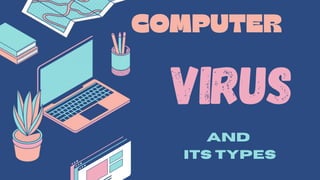
TLE ICT 10 Q3 - VIRUS and its Types.pptx
- 2. What is a Virus on a computer? • •
- 3. What is a Virus on a computer? •
- 4. • A virus is simply a computer program-- it can do anything that any other program you run on your computer can do. Some viruses are designed to deliberately damage files, and others may just spread to other computers. Do you wonder..
- 5. • Viruses infect computers discreetly, and they’re often designed to destroy personal files or gain control of devices. Making copies of themselves, computer viruses spread across devices and networks like biological viruses passing from one person to the next. And just like the biological versions, some computer viruses are simply annoying while others can cause major damage.
- 6. • In the early days of computers, viruses were spread between devices using floppy disks. It spread through almost any method of file sharing, as long as the virus can avoid detection by antivirus programs. • Nowadays, viruses can still be spread via hard disks and Universal Serial Bus (USB) devices, but they are more likely to be passed between devices through the internet and by malicious online downloads. • Computer viruses can be spread via email, with some even capable of hijacking email software to spread themselves. Others may attach to legitimate software, within software packs, or infect code, and other viruses can be downloaded from compromised application stores.
- 9. •
- 10. •
- 11. •
- 12. •
- 13. •
- 14. • Slow or stuttering performance • Corrupted or deleted files • Incessant pop-ups or adware • Program failure and operating system crashes • A constantly spinning hard drive • Malfunctioning apps, files, and other programs • Steal personal data — such as usernames, passwords, and credit card details • Spam all of your contacts and try to trick them into downloading the virus
- 15. Common Types of Computer Viruses
- 16. 1. File-infecting Virus A virus that attached itself to an executable program. Itisalsocalledaparasiticviruswhichtypicallyinfects files with .exe or .com extensions. Some file infectors can overwrite host files and others can damage your harddrive’sformatting.
- 17. 2. Macro Virus This type of virus is commonly found in programs such as Microsoft Word or Excel. These viruses are usually stored as part of a document and can spread when the files are transmitted to other computers, often through emailattachments.
- 18. 3. Browser Hijacker This virus targets and alters your browser setting. It is often called a browser redirect virus because it redirects your browser to other malicious websites thatyoudon’thaveanyintentionofvisiting.Thisvirus can pose other threats such as changing the default homepageofyourbrowser.
- 19. 4.Web Scripting Virus A very sneakyvirusthattargetspopularwebsites.What this virus does is overwrite code on a website and insert links that can install malicious software on your device. Webscriptingvirusescanstealyourcookiesandusethe information to post on your behalf on the infected website.
- 20. 5. Boot Sector Virus These viruses are once common back when computers are booted from floppy disks. Today, these viruses are found distributed in forms of physical media such as external hard drives or USB. If the computer is infected with a boot sector virus, it automatically loads into the memory enabling controlofyourcomputer.
- 21. 6. Polymorphic Virus This virus has the capability to evade anti- virus programs since it can change codes everytimeaninfectedfileisperformed.
- 22. 7. Resident Virus A resident virus stores itself on your computer’s memory which allows it to infect files on your computer. This virus can interfere with your operating system leading to file and program corruption.
- 23. 8. Multipartite Virus A type of virus that is very infectious and can easily spread on your computer system. It can infect multiple parts of a system including memory, files, and boot sectorwhichmakesitdifficulttocontain.
- 24. • Worm • ILOVEYOU • Stuxnet • Welchia • Tinba
- 25. • A computer worm is a type of trojan horse malware that, unlike traditional viruses, does not require the user's intervention to spread from device to device. After breaching a system, it can spread from one computer to another without human intervention.
- 26. • The ILOVEYOU virus is an overwrite virus. This virus disguised itself as a love letter from one of its victims' contacts and spread via email. • It was the most damaging malware event of all time when it occurred in 2000. In just about 10 days, it reached an estimated 45 million users and caused $10 billion in damages.
- 27. • Stuxnet is a highly sophisticated computer worm that was designed to attack Iran's nuclear facilities but has since mutated and spread to other industrial and energy-producing facilities.
- 28. • The Welchia worm, also known as Nachi, is a Nematode that deletes Blaster and fixes the vulnerabilities that allow them to exist. While it has no malicious intent, it does tend to slow down computers and networks. On August 18th, 2003, it was first reported.
- 29. • Tinba is a trojan that infects end-user devices and attempts to compromise and steal funds from their financial accounts. The Trojan was discovered in 2012 and initially infected thousands of Turkish computers.
- 30. THANK YOU FOR LISTENING!! We hope you learned something new.